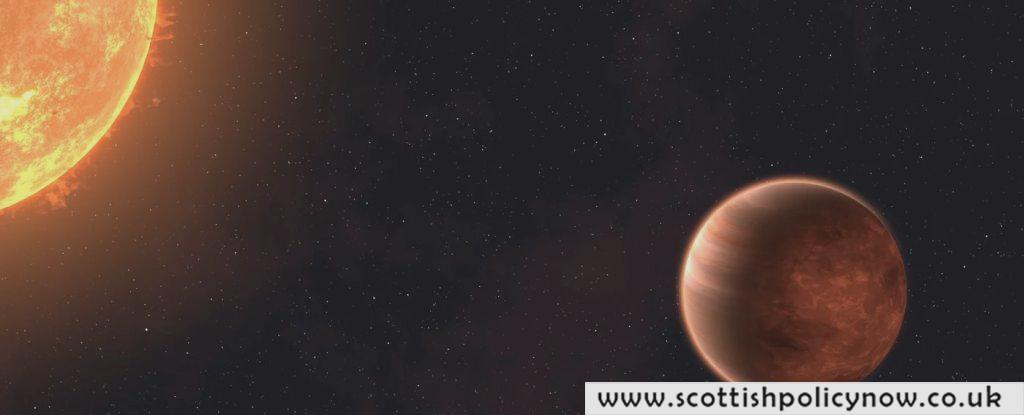It’s perpetually dark and stormy on the night side of the exoplanet Astrolábos.
In the eternal shadow opposite its host star WASP-43, the atmosphere of the gas giant known as WASP-43b swirls with tempestuous clouds composed not just of gas but potentially minerals, as the close proximity to its star causes night-time temperatures high enough to vaporize rock.
“With the advanced capabilities of JWST, we’ve uncovered WASP-43b in extraordinary detail,” notes astronomer Laura Kreidberg from the Max Planck Institute for Astronomy in Germany.

“We’re observing a dynamic and harsh world with intense winds, drastic temperature fluctuations, and unevenly distributed clouds likely consisting of rock particles. WASP-43b illustrates the extreme range of climates possible on exoplanets and highlights Earth’s uniqueness.”
Discovered in 2011, Astrolábos was initially noted as the nearest ‘hot Jupiter’—a large exoplanet close to its star with an orbit of only 19.2 hours.
Such hot Jupiters defy our standard models of planetary formation as they seem too close to their stars to have originally formed there, suggesting they must have migrated inward from a more distant orbit.
The frequency of hot Jupiters found suggests this inward migration is common, making them perfect subjects for studying extraterrestrial planetary systems. Their frequent transits in front of their host stars allow for regular atmospheric investigation.
As a hot Jupiter transits, some starlight passes through its atmosphere, absorbing or amplifying certain wavelengths, which scientists analyze to identify atmospheric components.
Observing these transits also helps to discern the exoplanet’s light emission by comparing changes in brightness and spectrum, revealing the amount of heat the exoplanet emits.
These signals are subtle, yet their detection is aided by the short orbits, allowing data from multiple transits to be aggregated, or even capturing an entire orbital period at once.
Previously, Hubble telescope data had indicated water vapor in Astrolábos’s atmosphere. Now, with the more powerful JWST, our understanding of the atmospheric dynamics has deepened.
Mid-infrared observations by JWST have measured the exoplanet’s temperatures, confirming its ‘tidally locked’ nature: one hemisphere eternally faces the star and reaches 1,250 degrees Celsius (2,282 Fahrenheit), while the other, the night side, cools to about 600 degrees Celsius (1,112 Fahrenheit).
This temperature disparity suggests a complex atmosphere: likely cloud-filled on the cooler night side, blocking infrared emissions, and clear on the blistering day side where clouds cannot form.
JWST data also provided insights into atmospheric composition, confirming water presence but surprisingly not detecting methane, expected on the cooler night side from reactions among carbon monoxide and hydrogen.
This absence might result from swift cross-winds, moving at up to 9,000 kilometers per hour (about 5,000 miles per hour), which could prevent methane from forming by whisking its precursor elements away too quickly.
“If the atmospheric gases circulate rapidly enough between the day side and night side,” explains UK-based astronomer Joanna Barstow, “chemical reactions don’t have enough time to produce detectable methane on the night side.”
This finding suggests chemical uniformity across Astrolábos’s atmosphere, challenging prior assumptions and indicating the need for further studies on the impacts of uneven heating on such extreme worlds.
The findings have been published in Nature Astronomy.








